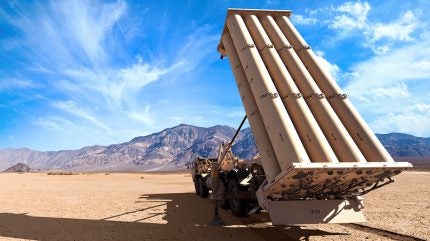
The US Missile Defense Agency has awarded Lockheed Martin a follow-on development contract, with a ceiling value of up to $2.8bn for Terminal High Altitude Area Defense (THAAD) systems.
This indefinite delivery and indefinite quantity (IDIQ) contract supports the continued development of the THAAD’s capabilities over the next five years – with two options to extend – for a period of up to ten years.
Recent THAAD development has evolved under the auspices of the weapon system’s manufacturer and US defence prime, Lockheed Martin, since the THAAD Advanced Capability Development contract was first agreed in 2012. However, the US government has supported the programme since the late 1980s.
According to Lockheed Martin, the latest development advances the interceptor’s capabilities against increasingly complex missile threats.
THAAD provides the upper tier of a ‘layered defensive shield’ to protect high-value strategic or tactical sites such as airfields or populations centres. The missile defence system intercepts exo-atmospheric and endo-atmospheric threats.
The sites would also be protected with lower and medium-tier defensive shield systems, such as the Patriot PAC-3, which intercepts hostile incoming missiles at 20 to 100 times lower altitudes. Notably, the THAAD can also integrate and fire PAC-3 MSE missiles.
How well do you really know your competitors?
Access the most comprehensive Company Profiles on the market, powered by GlobalData. Save hours of research. Gain competitive edge.

Thank you!
Your download email will arrive shortly
Not ready to buy yet? Download a free sample
We are confident about the unique quality of our Company Profiles. However, we want you to make the most beneficial decision for your business, so we offer a free sample that you can download by submitting the below form
By GlobalDataPentagon pursues a ‘missile defence shield’
Following the leadership transition in Washington at the end of January, the Pentagon, headquarters of the US Department of Defense (DoD), declared its policy to develop an “Iron Dome for America.”
Aimed at protecting US airspace from a range of threats – hypersonic, ballistic, and cruise missiles, as well as other advanced aerial attacks – the new policy will replicate the Israeli-style missile defence shield, based on the short-range Iron Dome missile defence system.
It should be noted, however, that Iron Dome is just one layer within such an interceptor ‘shield’.
Other medium and long-range systems such as the the MIM-104 Patriot, with a maximum range of 99 miles, and THAAD, which can intercept threats at up to 124 miles and at an altitude of 93 miles.
The DoD will deliver a reference architecture for such a missile defence shield to President Donald Trump sometime in the next two months.
For more on missile defence developments please review the next issue (151) of Global Defence Technology.



